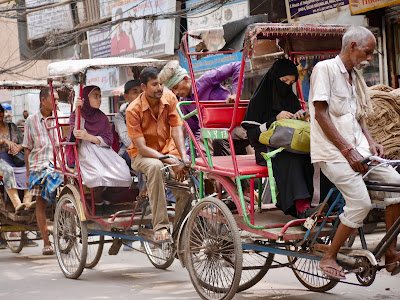Chawri bazaar is a sprawling shopping area in Old Delhi. You can find just about everything here but the traditional specialisms have been copper and brass items, especially statues of Hindu deities as well as paper, cards and wallpaper. Over time the choice of goods has expanded to include electrical items, machine parts, glass, medicine, clothing, fruit and vegetables. There are also many small stalls and shops selling tea and snacks to the bazaar's thousands of workers. From morning to night the streets are packed with people selling and shopping whilst porters carry impossible loads from one place to another. As I stood watching one man lift a large package on to his back, his colleagues told me it weighed 75 kilograms. With a little help from his friends he pulled it onto his back, smiled and went on his way.
The bazaar's streets are narrow and busy - clogged with rickshaws, scooters, motorbikes, carts, small vans, bicycles and the occasional school transport vehicle. Although cars are not supposed to pass through, they sometimes do, adding to the chaos that inevitably comes to a crescendo in the afternoon when drivers struggle to avoid bumping into each other and workers step into the melee directing drivers wanting to reverse, go forward or u-turn in order disentangle themselves from the crush. Sometimes tempers fray but things calm down very quickly when the traffic starts moving again. Friends in Delhi think I am a little strange but I love traveling through Chawri in a rickshaw, watching the traffic and occasionally engaging in friendly chatter with people in adjacent vehicles when things grind to a halt. On my recent visit I was even offered a bite of a burger by a young couple enjoying a take-away lunch in the next rickshaw.
The bazaar has quite a history. Founded in 1840, it was the first wholesale market in Delhi and originally boasted many fine mansions. It was also a centre for Tawaif culture. Tawaif were high class courtesans, skilled in music, dance, theatre, good manners and Urdu literature. They served the Indian nobility in the way that Geishas served their Japanese counterparts. Extensive study was required before the young women were brought into service and when this training was complete a celebration known as missi took place during which their teeth would be blacked out. Some of the Tawaif rose to positions of influence, especially in Lucknow which was also an important centre of their culture. However things deteriorated during the period of British rule, the mansions disappeared and prostitution became widespread on the upper floors of the Chawri.
Today the bazaar is a photographer's dream but is also extremely challenging with only a second to get a candid shot before someone or something blocks your view or needs you to move so that they can make a delivery. Last year I concentrated on talking to and photographing some of the casual workers who spread their tools on the pavement, waiting for customers to come and offer them day work as carpenters or decorators. This time I gave up trying to get clear shots and settled instead for glimpses of life in the bazaar. It was my first attempt at something like this so I had lots of unusable images but also a few that I was happy with. Shooting the passenger traffic as it passed also allowed me to capture images of women, noticeably missing from the portraits I took here, mainly due to the absence of women in the street in this part of the city - other than passing through in rickshaws. And speaking of rickshaws I was taken by surprise on one of my forays in here when I noticed none other than Munaji, who I met and wrote about last year, calling and waving to me from one of these ubiquitous vehicles as she went by. Recognised in Chawri Bazaar. Fantastic!
Last year I was able to give several of the labourers a copy of their photographs. This time I again looked for some of those I'd been unable to find but was unsuccessful. Change is a constant in such a large city and people come and go so it was unlikely that I would find all of them again. However, one constant is Aslam, the friendly owner of the Vespa Glass Service on the edge of the bazaar. I photographed him last year and in his absence handed the picture to his son the next day. I passed by the shop again on my most recent visit He saw me, smiled, took the photograph from his desk and waved it at me. He still has the best smile in the market. Both Aslam and Chawri really are Delhi delights.
You can see more pictures from India here.







No comments:
Post a Comment